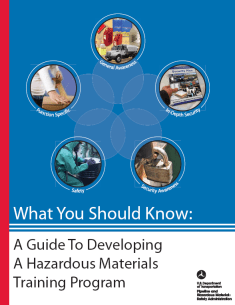 This guidance document (A Guide to Developing A Hazardous Materials Training Program – link at the bottom of this post) explains the training requirements in the Hazardous Materials Regulations, identifies those employees who must be trained, and provides a tool to help hazmat employers determine what type of training and training environment may be best for their employees.
This guidance document (A Guide to Developing A Hazardous Materials Training Program – link at the bottom of this post) explains the training requirements in the Hazardous Materials Regulations, identifies those employees who must be trained, and provides a tool to help hazmat employers determine what type of training and training environment may be best for their employees.
Hazardous materials transportation is a process that involves people performing functions related to handling, packaging, storing, moving, loading and unloading of hazardous materials, and responding to emergency situations while such materials are in transportation. It includes employees responsible for the safe transportation hazmat. The process also incorporates functions to design, manufacture, fabricate, inspect, mark, maintain, recondition, repair, or test a package, container or packaging component used in transporting hazardous materials. With such a complex process, the United States Department of Transportation (DOT) has identified human error as a contributing cause for most hazmat transportation incidents.
Human error may result from a variety of factors including:
- Lack of knowledge leading to the mishandling of hazmat
- Lack of knowledge leading to undeclared shipments
- Lack of awareness that hazmat is present
- Failure to follow established safety procedures
- Lack of understanding of one’s role during an incident should one occur
- Lack of knowledge on how to respond to an incident if one occurs
Hazmat incidents caused by human error can be reduced through the implementation of an effective
training program. An effective training program is a systematic method for providing training, which
includes tests and quizzes. It may consist of materials such as handouts, overheads, videos, and exercises,
as well as, interactive computer based training, tests and quizzes and, where there is an instructor, the
instructor’s notes or course outline. The training program may be a tutored or self-study course. The
training provider may be the hazmat employer or an independent training provider.
An effective training program:
- Develops a strong safety culture
- Heightens employee safety by helping employees protect themselves
- Improves a company’s effectiveness, effi ciency, and productivity
- Increases employee skills
- May prevent regulatory sanctions
- Aids in ensuring safe and secure shipments of hazardous materials
- Reduces likelihood of catastrophic event such as fi re aboard aircraft
- Provides employees with understanding of why compliance and safety are necessary
Download the Guide (.pdf) from the DOT Website HERE.
Source: US DOT
